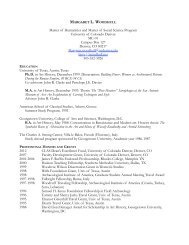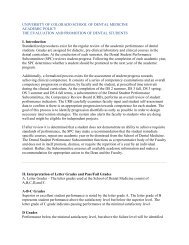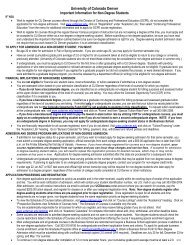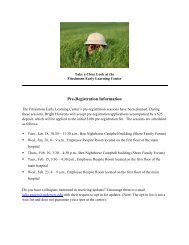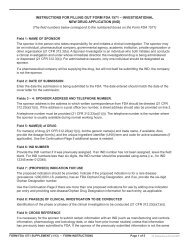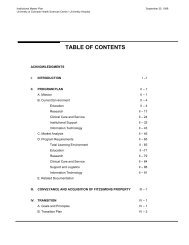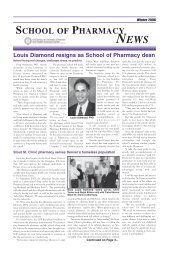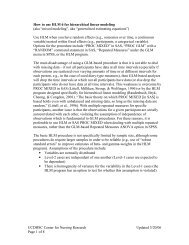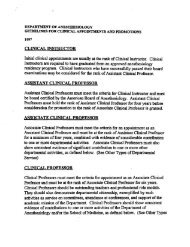Strategic Plan - University of Colorado Denver
Strategic Plan - University of Colorado Denver
Strategic Plan - University of Colorado Denver
Create successful ePaper yourself
Turn your PDF publications into a flip-book with our unique Google optimized e-Paper software.
VII. EPILOGUE<br />
Epilogue<br />
We had a choice to make with this strategic plan. With all the changes over the last<br />
decade that have resulted in the new UC <strong>Denver</strong>, we could have chosen to take an<br />
“institutional breather” and simply maintain our current position. Or we could have<br />
chosen to maximize the opportunities available to us. We have chosen the latter<br />
course. We have done so because we are an institution that:<br />
has too much potential to be comfortable with “the new status quo;”<br />
is used to rapid change, and we believe this will become a competitive<br />
advantage in future years;<br />
has yet to realize the full benefits <strong>of</strong> academic consolidation;<br />
possesses more superior facilities for education and research in the health<br />
sciences than many institutions <strong>of</strong> our type around the world;<br />
believes it has more to <strong>of</strong>fer the city, state, nation, and world and also believes<br />
that it has a responsibility to do so;<br />
recognizes that the higher education marketplace is now a global one<br />
and, that to be competitive, we must be an institution with a global mindset<br />
and reach;<br />
can benefit from its vibrant metropolitan location in an attractive and<br />
growing part <strong>of</strong> the country; and<br />
can leverage the benefits <strong>of</strong> our diverse undergraduate student body as we<br />
seek to enhance the diversity <strong>of</strong> our graduate and pr<strong>of</strong>essional students, faculty,<br />
and staff.<br />
Richard Hamman, MD, DrPH, is<br />
dean <strong>of</strong> the planned <strong>Colorado</strong><br />
School <strong>of</strong> Public Health,<br />
scheduled to open summer 2008<br />
as a collaboration between the<br />
<strong>University</strong> <strong>of</strong> <strong>Colorado</strong> <strong>Denver</strong>,<br />
<strong>Colorado</strong> State <strong>University</strong>, and the<br />
<strong>University</strong> <strong>of</strong> Northern <strong>Colorado</strong>.<br />
Such an ambitious plan is not without risks, nor is it immune from criticism. The<br />
risks include possible failure to accomplish all the priorities and goals. We accept<br />
that risk, knowing that this is more <strong>of</strong> a journey than a destination. We also know<br />
that we don’t fully control our destiny. External factors, from the resource environment<br />
to local and world affairs, can intrude on our plans over the years. Yet, we<br />
cannot be so risk-averse that we develop a plan that cannot be criticized. For<br />
example, some <strong>of</strong> our stakeholders worry that our global ambitions will diminish<br />
our attention to our statewide responsibilities. We have listened throughout the<br />
process, been responsive to concerns, and sought and achieved a general consensus.<br />
Yet, we have not compromised our determination to be bold in our plan.<br />
We also realize that developing the plan and implementing the plan are two very<br />
different activities. In the implementation phase, we will need to develop precise<br />
benchmarks and measurable outcomes, evaluation processes, specific timelines, and<br />
clear lines <strong>of</strong> responsibility and accountability. Our resource acquisitions and budget<br />
allocations will need to be intentionally focused by the plan and evidence-based.<br />
<strong>University</strong> <strong>of</strong> <strong>Colorado</strong> <strong>Denver</strong> 39




